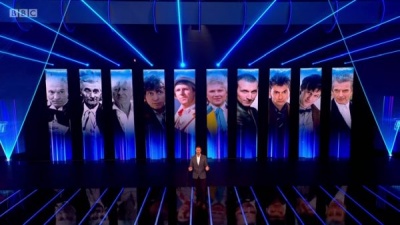Catchpoint
Synopsis
BBC1's new Saturday evening family quiz-and-game show for spring 2019, Catchpoint was very simple. Here are ten pictures. Here is a question. We'll drop a ball above the correct answer. Catch the ball and win some cash.
The actual format is a little more complex than that, but not much. In "First Catch", our team of two see two questions, for £250 and (using a smaller ball) for £500. In each question, the team names their "catchpoint" - the answer they think is right. There's a countdown using bleeps, and the ball drops.
"Decoy Catch" involves a subtle variation, a ball is dropped from every answer, not just the right one. The team wants to catch the pink balls and not the blue ones. £750 and £1000 for these two questions.
"Quick Catch" is 45 seconds of questions, using a single set of answers - usually a map, or a scale of numbers. There's £300 for each ball caught, and the clock only runs while the contestants hear or think about the question.
The winners play "Final Catch", one last question. Unlike in earlier rounds, the team picks their catchpoint by eliminating all the other answers. At this point, they can choose to walk away with the money from the main game - typically £2500 or so - or play this final question for £10,000. The second series did away with this, and had each 'half' aim for a ball in their half, each half for what they banked (so up to double).
Catchpoint certainly has plenty of catching - the show has one gimmick and uses it as often as it can. There's a wide variety of questions, including some memory challenges, and we can make a reasonable guess at the answers even when we don't know. Paddy keeps the tempo up, he doesn't have much time to know the contestants but still helps their personalities shine. It's a fun show that never takes itself too seriously, even when playing for serious cash.
Inventor
"A Possessed format", according to the end credits. 12 Yard provided the question team, with names familiar from Eggheads.
Title music
Elba Studios, credited for "Original music".
Trivia
Potion Pictures made the graphics design, and Lumina the big display. Both are familiar names for these jobs.
When the show was commissioned, Possessed gave us a full description:
- The very first physical game show where contestants can get their hands on the answer using both their brains and balls. Brains are required to answer the various questions asked and then players will need to think fast as they try to catch balls of various sizes which will be dropped from the studio ceiling.
- The premise of the game is simple, don’t drop the ball! In the studio, ten large rectangular LED screens are positioned along the back wall of the Catch Zone. These screens will display the answers to each question that the players will face. Suspended above the Catch Zone are ten trapdoors – each containing a ball. Only the trapdoor that is located directly above the correct answer screen will open and send a ball plummeting to earth.
- All the players must do is stand in front of the screen that they think is displaying the correct answer, press the button to release the ball and then catch the ball when it drops from the correct answer trapdoor. If you’re standing in the right place it should be a piece of cake but get it wrong and you’re going to have to rely on fast moves and quick reflexes not to drop that ball!
The "Doctor Who" actor in 1977 was Tom Baker, the fourth photo from the left.
The Olympian Jared Deacon was a contestant on the second episode.




